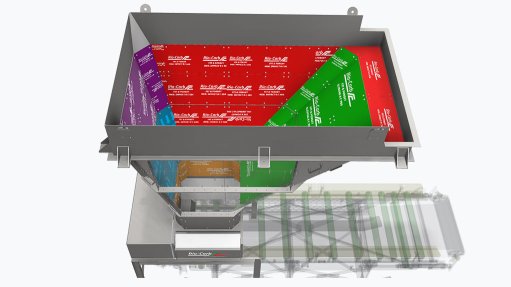Record platinum deficit, above-ground platinum stocks decimation on the way

World Platinum Investment Council Research Director Edward Sterck interviewed by Mining Weekly’s Martin Creamer. Video: Darlene Creamer
The biggest takeaway from the Platinum Quarterly report and updated full-year forecast of theWorld Platinum Investment Council (WPIC) is the predicted record platinum deficit of more than a million ounces as well as the nigh wipe-out of above-ground platinum stocks.
Speaking to Engineering News & Mining Weekly on the WPIC’s latest Platinum Quarterly and updated full-year forecast, WPIC research director Edward Sterck pointed out that forecast is the biggest platinum deficit on record in both ounce terms and as a percentage of demand.
By the end of this year, it is estimated that above-ground platinum stocks will be down to about six weeks of supply, which the market is expected to begin reflecting, elaborated Sterck.
With total supply flat, total demand will lift 27%, with automotive recovery up 13%, or 381 000 oz, driven by greater-than-expected vehicle production, increased substitution and higher loadings.
Industrial demand is heading for a record 14%-higher 2 667000 oz through capacity expansions, and total 2023 investment demand is forecast to be 386 000 oz, along with a strong year-on-year improvement in investment demand.
The core drivers of platinum’s expected 27% demand growth in 2023 were clear to see in the second quarter of this year, and built upon foundations laid in the previous two quarters, said Sterck.
The research shows that automotive and industrial demand growth underpin total demand growth in 2024 and beyond, which offers both short- and long-term value incentives for investors, as well as protection from downside risks presented by inflationary headwinds, as well as a high-interest-rates environment.
Continuing electricity shortages in South Africa are exacerbating the deficit and maintaining the downside risk.
Meanwhile, the link between platinum and the green hydrogen economy is increasingly better known owing to green hydrogen produced by platinum-containing electrolysers having a significant role to play in the energy transition.
Mine supply is expected to be broadly flat year-on-year and so is recycling supply, said the WPIC.
“Over the course of probably 2021 and 2022, we saw quite strong disinvestment from platinum. “This year, we’re expecting that to move back into pretty reasonable positive territory. All of those factors in aggregate, ultimately result in that strong 27% year-on-year growth in demand,” Sterck tells Engineering News & Mining Weekly.
How significant is automotive and industrial demand growth?
Both are expected to grow quite significantly. Automotive demand is being driven by ongoing substitution of platinum and palladium. It’s also being supported by an increase in vehicle production numbers this year. Over the last couple of years, we saw vehicle production or vehicle outputs, being artificially suppressed by the semiconductor shortage, so, effectively, the automakers simply couldn’t secure enough semiconductors to manufacture cars. This year we’re seeing that situation significantly ease and then you’ve also got a tightening of emissions legislation which is resulting in sort of more PGMs being used in the exhaust treatment systems for heavy-duty vehicles and for nonroad vehicles in particular. That’s a big factor for the automotive side. On the industrial side, we’ve got big capacity additions in the chemicals industry. Those came through in the second quarter of this year, but also in the second half of the year, quite a number of new glass manufacturing facilities are expected to come online, and those two factors are really what’s driving industrial demand growth. I guess we’re only talking about 2023, but as the standard at the moment, it’s difficult to see any real changes to those demand drivers going forward, so we would be expecting to see continued strength in demand in subsequent years as well.
Investment demand has shown an uptick. Do you think this is a sustainable situation?
It really depends on what’s happening more broadly on the kind of investment world. We’ve had an improvement to bar coin demand that’s largely being driven by fewer sell-backs occurring in in Japan, where platinum investors react quite quickly to changes in the yen platinum price and they will liquidate holdings as well as purchase new holdings when the price is attractive to them, so that’s a big factor for overall bar and coin demand this year because it’s a swing factor from disinvestment, positive investment demand. Then, in terms of exchange-traded fund (ETF) investment demand, it really depends on what is happening to the South African mining companies. To a certain degree, there is an element of ‘do you own more of the miners, or do you own more of the metal’, and right now there seems to be, this year, a little bit more of a favourable inclination amongst investors for the metal over the equities. But it also depends somewhat on what’s happening with interest rates. “If we see interest rates going up, as they have done throughout most of this year, for a lot of investors that is a factor that would play against ETFs, which are non-yielding assets, and so they’re more likely to look to place their investment funds elsewhere. “As things stand this year, although we’ve had that situation, we’ve still seen net inflows into the ETFs and we’re expecting those to be broadly sustained, with a little bit of disinvestment, but broadly remain in positive territory through the rest of this year.
What is the likelihood of hydrogen-related platinum demand becoming a proxy for investors looking for exposure to global decarbonisation?
As things stand right now, it’s worth remembering that the hydrogen demand for platinum is still very small. It’s growing quickly, but off a very small base, so the market needs to get to a point where changes in hydrogen demand begin to be a price-setting factor for platinum. It’s only at that point that platinum can become that proxy for exposure to the hydrogen economy and to global decarbonisation. I think we’re still a few years away from reaching that point, but it is something that we are expecting to manifest in the future.
On the supply front, why is the recycling of platinum declining?
Recycling has been held back by some of the factors that have also influenced automotive production. In terms of automotive recycling, the recycling of spent catalytic converters from end-of-life vehicles, we’ve seen a shortage of end-of-life vehicles, principally as a result of a semiconductor shortage. That, in itself, has resulted in fewer new vehicles being manufactured, and so, therefore, consumers have been forced to run existing vehicles for longer and that plays through into the reduced scrap availability. That’s been accentuated somewhat by a controversy in North America, where one of the aggregators of spent auto catalysts at the end of last year was raided by the FBI and they’ve been accused of dealing in stolen catalytic converters. Now, for the recyclers in North America, they’ve suddenly become very worried about the provenance of the scrap that they’ve been recycling, and so trying to prove that provenance has resulted in quite a significant decrease in their recycling volumes whilst they work through that sort of uncertainty and trying to ensure that their supply chains are completely clean. Those are the facts on the automotive side. We’re also seeing jewellery sell-backs, particularly in China and in Japan. Consumers in those countries typically, if they’re buying new platinum jewellery, would often sell back an old piece of jewellery from that purchase, and those volumes are just down and that’s playing through in the lower jewellery recycling rates as well.
Finally, what, in your view, should be the biggest takeaway from the latest Platinum Quarterly report and updated full-year forecast?
The main thing is it’s the biggest deficit on record, both in ounce terms and as a percentage of demand, and it’s worth thinking about how that deficit is being met at the moment. There are above-ground stocks that are in excess, but those are being run down really significantly as a result of this substantial deficit. Over the last few years, we’ve also seen significant excess imports into China and so we estimate that a significant majority of those above-ground stocks are now sitting in China, and therefore not necessarily available to satisfy any deficits in the rest of the world. If you run the maths on that, for the rest of the world, you get down to only about six weeks of above-ground stocks in terms of weeks of demand at the end of this year, so certainly, we’re expecting the market to begin to reflect the realities of those falling above-ground stocks coming through the rest of this year and into next year.
Comments
Press Office
Announcements
What's On
Subscribe to improve your user experience...
Option 1 (equivalent of R125 a month):
Receive a weekly copy of Creamer Media's Engineering News & Mining Weekly magazine
(print copy for those in South Africa and e-magazine for those outside of South Africa)
Receive daily email newsletters
Access to full search results
Access archive of magazine back copies
Access to Projects in Progress
Access to ONE Research Report of your choice in PDF format
Option 2 (equivalent of R375 a month):
All benefits from Option 1
PLUS
Access to Creamer Media's Research Channel Africa for ALL Research Reports, in PDF format, on various industrial and mining sectors
including Electricity; Water; Energy Transition; Hydrogen; Roads, Rail and Ports; Coal; Gold; Platinum; Battery Metals; etc.
Already a subscriber?
Forgotten your password?
Receive weekly copy of Creamer Media's Engineering News & Mining Weekly magazine (print copy for those in South Africa and e-magazine for those outside of South Africa)
➕
Recieve daily email newsletters
➕
Access to full search results
➕
Access archive of magazine back copies
➕
Access to Projects in Progress
➕
Access to ONE Research Report of your choice in PDF format
RESEARCH CHANNEL AFRICA
R4500 (equivalent of R375 a month)
SUBSCRIBEAll benefits from Option 1
➕
Access to Creamer Media's Research Channel Africa for ALL Research Reports on various industrial and mining sectors, in PDF format, including on:
Electricity
➕
Water
➕
Energy Transition
➕
Hydrogen
➕
Roads, Rail and Ports
➕
Coal
➕
Gold
➕
Platinum
➕
Battery Metals
➕
etc.
Receive all benefits from Option 1 or Option 2 delivered to numerous people at your company
➕
Multiple User names and Passwords for simultaneous log-ins
➕
Intranet integration access to all in your organisation















